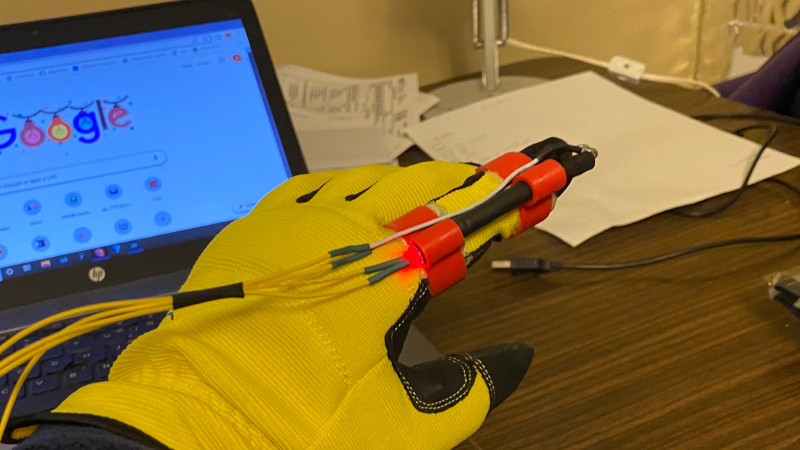When most of us think of glove controllers, the first which comes to mind is Nintendo’s PowerGlove, which promised much more than it delivered. But the idea persists, and from time to time we see them here at Hackaday. [Gord Payne] has one with an elegant sensor solution, it detects finger movement using a light dependent resistor.
The cleverest designs are those which are the simplest, and this one eschews complex mechanisms and exotic parts for a simple piece of flexible tube. At one end is an LED and at the other the LDR, and when attached to a glove it provides a finger sensor without the fuss. The amount of light reaching the LDR from the LED decreases as the pipe is bent, and with a simple divider circuit a voltage can be read by an Arduino. You can see it in action in the video below the break, where the glove flexing controls a servo.
Perhaps this might revitalize a bit of interest in glove controllers, something we probably don’t see too many of. Those Nintendo PowerGloves do still crop up from time to time though.
















> The cleverest designs are those which are the simplest
hmm, that’s an oversimplification ;)
There is certainly a beauty in the simplicity of a design. Unfortunately, there is never a free lunch, things are always a trade off, sure it seems to work. How repeatable is it, how accurate is it, how sensitive is it, how linear is it. how easy is it to make and does every sensor need to be calibrated in order to output the same results as the sensor you made yesterday. And finally how easy is it to process the results.
There was a system a short while ago, that used strips of electrodes forming a capacitance based upon the movement of the strips https://hackaday.com/2020/06/26/slipping-sheets-map-multiple-bends-in-this-ingenious-flex-sensor/
If it there was to be a contest of which system is “the simplest” I would put my money on that design.
> https://hackaday.com/2020/06/26/slipping-sheets-map-multiple-bends-in-this-ingenious-flex-sensor/
Now that is impressive! I wonder why nobody has turned this into a product?
Who would really want it? I think for most finger tracking applications people would rather use cameras or visual tracking of some kind.
Kinda like the guy above said it’s far more complex to make but “yeah just use your hands as normal the cameras and computers will track them” is much much simpler and user friendly than strapping on and calibrating gloves etc
Already covered here 12 years ago, just different light detection technology approach: https://hackaday.com/2011/10/21/building-optical-flex-sensors/ Maybe it is wise to also add this link in the entry ;)
you saved me some googling, also recalled something like this
Yup, I was inspired by that post to make a similar version, but using another LED as the light sensor.
Closeup of the sensor: https://twitter.com/koppanyh/status/988233922927513601
The sensor in use for scrolling: https://twitter.com/koppanyh/status/990125064522682373
are there any cheap hacks like this to make a pressure sensor, since commercial ones are quite spendy.
There are some designs that use velostat bags here is one example http://iainmccurdy.org/diy/forcesensorlowprofile/forcesensorlowprofile.html . There is also the design where a barometer and covered in silicone rubber can be used. That would be a little more pricey of about $8.
I should have clarified better, i meant a diy sensor to measure air pressure, like the HX710B does. i was thinking of something like the coiled party whistles that unfurl when blown, but they don’t hold pressure well.
What about a strain gauge on a tin can?
Yeah there are commercial data gloves that use optical bend sensors. They require calibration of their range and tend to be a little fragile, but they do work. (I’m not sure if I was more annoyed about how they worked, or about how simple they seemed for how expensive they were)
This idea has a long history. Here’s Zimmerman’s patent on it from 1982: https://patents.google.com/patent/US4542291
I remember a friend building almost exactly this in highschool electronics with a picAXE micro, back in ~2005. It worked remarkably well for the cost. Glad to see others picking up this idea.